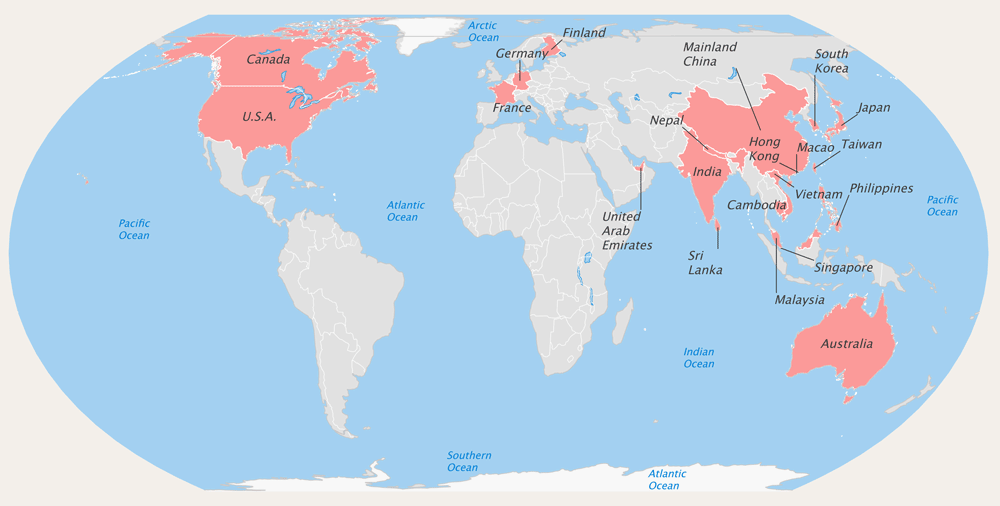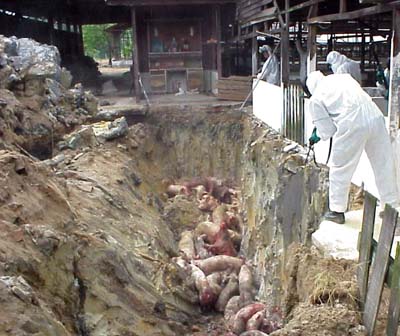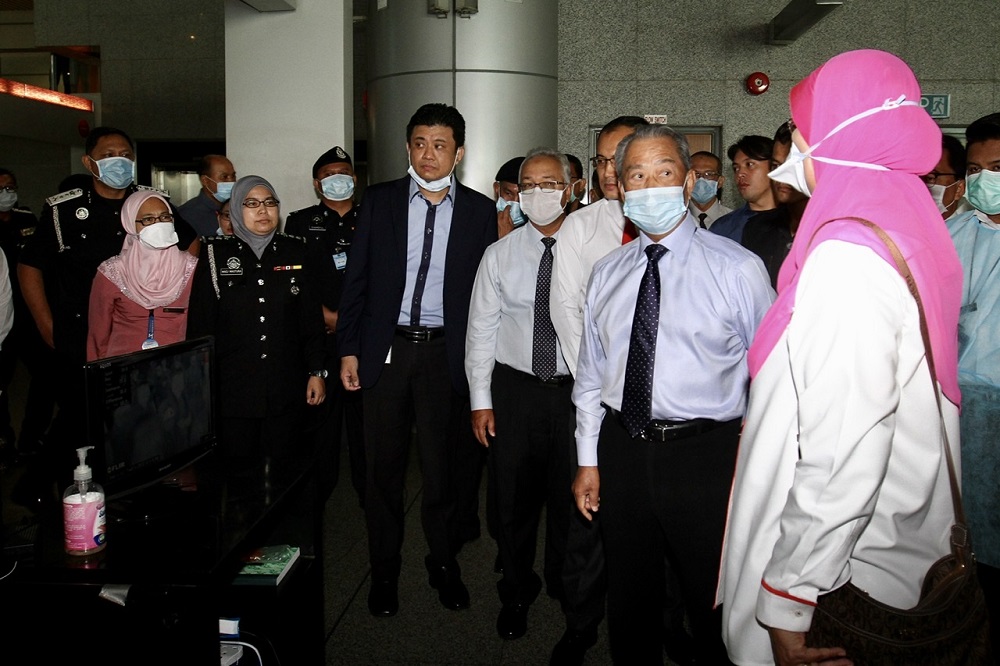Here’s one good reason why Malaysians should not worry about the coronavirus outbreak

- 1.5KShares
- Facebook1.4K
- Twitter19
- LinkedIn12
- Email16
- WhatsApp38
In case you’ve just descended from the mountains after years of honing your kung fu skills, here’s some bad news: the world is currently being threatened by a scary new kind of coronavirus. The World Health Organization (WHO) had recently declared the outbreak as a ‘public-health emergency of international concern (PHEIC)‘, about a month after it first reared its head.
It’s not really an overreaction. As of Monday (Feb 3rd), cases involving the new coronavirus (referred to as 2019-nCoV) have exceeded 17,000 on mainland China alone, with 361 dead so far. 2019-nCoV cases have also been reported in at least 20 other countries, including 10 cases in Malaysia.

The PHEIC declaration is saved for only the most serious, sudden and unexpected outbreaks crossing international borders, and according to Tedros Adhanom Ghebreyesus, WHO’s Director-General, it is declared for the 2019-nCoV because there’s no knowing what might happen to countries unprepared for it.
“Over the past few weeks, we have witnessed the emergence of a previously unknown pathogen which has escalated into an unprecedented outbreak. We don’t know what sort of damage this virus could do if it were spread in a country with a weaker health system,” – Tedros Adhanom Ghebreyesus, as reported by Business Insider.
Hearing all these, you might be tempted to trek back up the mountains, but wait! Put down your fishing basket and bindle, because some have actually found that…
Malaysia can handle pandemics even better than Singapore and Brunei
Says who? Says the Global Health Security (GHS) Index. The index, which is an assessment carried out by The Economist‘s Intelligence Unit with the help of an international panel of experts, assessed, scored and ranked 195 countries based on their preparedness in case an epidemic or pandemic hits. And before we get to Malaysia’s rankings, a side note since these words aren’t usually used in everyday conversation:
An epidemic is when a disease breaks out and actively spreads through a community at one time. Think 28 Days Later.
A pandemic is like an epidemic, but even more widespread, affecting several countries. Think World War Z.

Based on six categories (how well we prevent, detect, and respond to epidemics; how strong our health system is, how well we comply with international standards, and how vulnerable our country is), Malaysia scored a total of 62.2 points out of a possible 100, putting us at the 18th spot out of the 195 countries assessed.
This puts us higher than Singapore (24th) and Brunei (128th), the only two countries categorized as ‘High Income’ in Southeast Asia. In fact, within the region we are only behind Thailand (6th).
But what’s so good about Malaysia’s pandemic handling system, anyway? Well, you can check out Malaysia’s full report card here, but we were ranked the best in the world for these 6 indicators out of 34:
- Sharing our data across different government departments, which allows us to better plan and respond to outbreaks.
- Our public health and security authorities working with and considering each other in their emergency plans.
- Having trade and travel restrictions, like banning livestock from affected countries and screening travelers during an outbreak.
- Having a plan for communication for healthcare workers for all stages of an outbreak.
- Anticipating shortages in availability of protective equipment during outbreaks and having a stockpile ready.
- Having cross border agreements regarding response to public health emergencies, which would make regional response to outbreaks faster and smoother.
Wowza. There’s one more thing that we didn’t get the top ranking, for, but we did get 2nd place:
- Having a Crisis Preparedness and Response Center (CPRC) that coordinates an emergency response to outbreaks.

Just in case you skimmed the whole thing, the bottom line is that according to the GHS Index, we seem to know what we’re doing more than most other countries when it comes to handling pandemics, getting a score (62.2) that’s well above the global average (40.2) and the average of high-income countries (51.9) as well. But you might not be convinced with just the GHS Index, much like you are not convinced with your kung fu sifu’s Certificate of Excellence from the College of Drunken Monkey Style.
So moving on from theory to practice…
We’ve already survived several scary pandemics in the past
While we’re not sure when did we get so good at preserving ourselves, a 2006 government preparedness plan for influenza (the NIPPP) mentioned that we started putting together better pandemic plans since the Nipah virus outbreak in 1999.

For more detail on the Nipah virus, you can check out our (pretty interesting) article on that, but basically it’s a deadly virus that infects pigs, and later people living near pigs. Before the government identified and eradicated it, the Nipah virus outbreak lasted some nine months, during which it affected 265 people and killed 105.
To fix the situation, the government practically flattened the pig-farming village from where the virus originated and massacred like a million pigs. The place was also quarantined until the virus disappeared, and while many were unhappy with the incident (some even called the incident as one of the greatest government screw-ups when it comes to handling epidemics), since then the government had looked more deeply into disease handling in Malaysia.
In 2003, the world saw an outbreak of the Severe Acute Respiratory Syndrome coronavirus (SARS-CoV), and at its height it was estimated to have killed at least 106 people and infected 2,900 people worldwide. Malaysia responded to the threat by setting up a ministerial committee, as well as other measures like temporarily banning people from certain countries from entering.
“We have stopped the entry of (certain) tourists and monitored the issuance of visas… through these measures the disease will be contained in this country.” – Abdullah Ahmad Badawi, then acting Prime Minister, as reported by MalaysiaKini.
Together with the WHO, Malaysia have also done active contact tracing on suspected cases, which is basically tracking down everyone who has been in contact with the infected and screening them as well. Due to these measures, only 40 suspected cases of SARS were identified in Malaysia, with only one death. We’ve also got out of the less-widespread Middle East Respiratory Syndrome (MERS) which surfaced in 2014 through pretty much the same measures: quarantine and monitoring of at risk travelers. Like SARS, it seems like only one person died.

Perhaps the most deadly pandemic we’ve faced since the Nipah virus outbreak was the H1N1 pandemic in 2009 (aka the swine flu), which claimed between 151,700 to 575,400 lives worldwide during its first year. In Malaysia, there were around 12,307 reported cases, and only around 77 people died from it.
It could have been much worse, but judging by the paperwork, Malaysia was actually prepared for this outbreak, having drawn up a National Influenza Pandemic Preparedness Plan three years prior. Drawing from our experience from SARS and the Nipah virus, it outlined updated strategies and procedures in the event of an influenza outbreak.
There are probably more cases we can deliberate here, but this article is getting a bit too long already, so…
Will Malaysia be able to handle the 2019 coronavirus?

Based on previous cases, probably. The Health Minister Datuk Seri Dr Dzulkefly Ahmad has recently said that Malaysia’s preparedness for the new coronavirus, including facilities and relief teams, was already at its best even before the WHO held a meeting on the coronavirus outbreak.
“We understand the people’s concerns, but if it was to say that the MOH was slow to act, our National Crisis Preparedness and Response Centre (CPRC) at Sungai Buloh has been activated on Jan 5, right after we were made aware of the crisis, even before WHO held its meeting,” – Dr Dzulkefly, as reported by Malay Mail.
While it might sound like a typical PR response, one can see that the ministry is not taking the case lightly. Frontliners managing coronavirus cases are equipped with full protective gear, thermal scanners are set up at entry points, people entering Malaysia are dutifully scanned with 42,000 people scanned in Kelantan alone since January, suspected cases are isolated and put under quarantine, and nearly 150 Chinese visitors from Wuhan has been denied entry so far.

The government has also gone great lengths to control the public’s perception of the outbreak, from assuring that people won’t turn into zombies to arresting people over the spread of fake news regarding the outbreak, and while there’s always a possibility of the government downplaying how serious the outbreak is, for now, things seem under control. A representative from the WHO had even commended Malaysia on our transparency throughout the ongoing outbreak.
“…I think Malaysia is doing very, very well. They are very open, very transparent… They also post new information, very accurate information which is validated on their social media. They also are in close contact with the authorities of Singapore and the neighbouring countries. So we are impressed about the quality of the work,” – Dr Ying-Ru Lo, WHO representative to Malaysia, Singapore and Brunei, as reported by Malay Mail.
Despite Malaysia having pretty solid defensive measures against the coronavirus, we shouldn’t relax just yet. After all, this is a new virus, and besides the nine foreigners identified to have been infected with the coronavirus, now there’s a Malaysian case as well, plus two more from the group of Malaysians we brought back from Wuhan. So regardless of how good our system is, we should still be careful on our end as well.
While it was recently reported that Malaysia has already one coronavirus case healed…
“This showed that the 2019-nCoV infection is treatable and that patient can fully recover, similar to many other cases that have been reported in China. Perception among the public that the 2019-nCoV is fatal (could not be treated) after one has been infected by the virus is certainly wrong,” – Datuk Dr Noor Hisham Abdullah, Health director-general, as reported by NST.
…it probably wouldn’t hurt to practice common sense and keep ourselves safe until we know for sure what’s what. Wash yo’ hands, don’t sneeze on people, and practice your iron lung technique diligently. And if you do get a fever… go for a checkup.
- 1.5KShares
- Facebook1.4K
- Twitter19
- LinkedIn12
- Email16
- WhatsApp38



